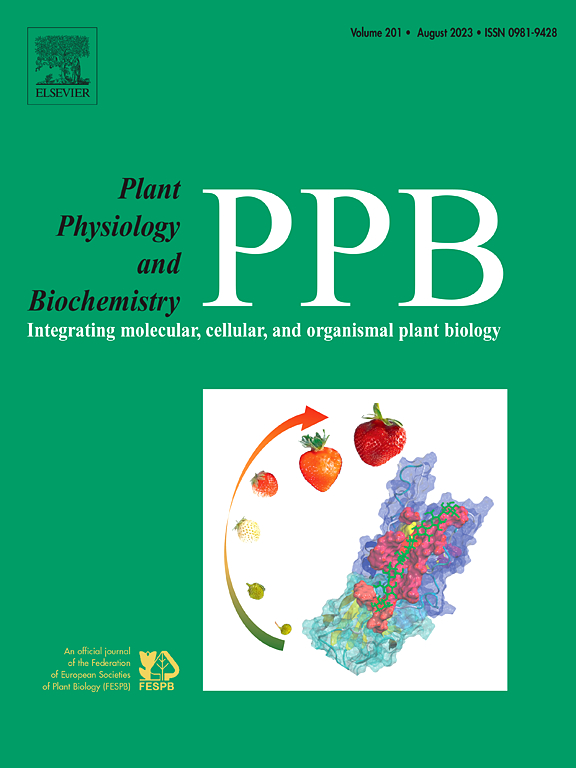敲除OsPHT4;4可增强水稻茎秆中噻虫嗪的积累,从而提高对褐飞虱的控制能力
IF 6.1
2区 生物学
Q1 PLANT SCIENCES
引用次数: 0
摘要
磷酸盐转运体 PHT4 在植物体内的养分转运中发挥着至关重要的作用。除了这一基本功能外,PHT4 还可能参与其他化合物(如抗坏血酸)的吸收和转运。然而,只有少数研究描述了 PHT4 的功能作用。在本研究中,我们发现了磷酸盐转运体 OsPHT4;4 在水稻中摄取和转运噻虫嗪(THX)的作用,并对其进行了功能鉴定。在酵母和爪蟾卵母细胞(X. laevis oocytes)中的异源表达实验表明,OsPHT4;4 能显著增强 THX 在细胞中的积累。OsPHT4; 4 蛋白包含 11 个跨膜螺旋,主要定位于质膜(PM)和叶绿体包膜。敲除 OsPHT4;4 蛋白降低了 THX 从茎到叶的转运效率,导致 THX 在茎中大量积累,从而增强了对褐飞虱 (BPH) 的控制,但对根到茎的转运没有影响。相反,OsPHT4;4的过表达增加了THX向叶片的转运,减少了THX在茎中的积累,从而削弱了对BPH的害虫控制效果。我们的研究结果表明,OsPHT4;4 在 THX 的特异性分布中起着关键作用,有助于害虫防治,同时也影响植物生长。这些发现为在作物管理中通过平衡害虫控制效果和植物健康来优化农药使用提供了基础。本文章由计算机程序翻译,如有差异,请以英文原文为准。
Knockout of OsPHT4;4 enhances thiamethoxam accumulation in rice stems for improved brown planthopper control
The phosphate transporter PHT4 plays a crucial role in nutrient transport within plants. In addition to this fundamental functions, PHT4 may also participate in the uptake and translocation of other compounds, such as ascorbate. However, only a few studies have characterized the functional roles of PHT4. In this study, we identified and functionally characterized the role of the phosphate transporter OsPHT4;4 in thiamethoxam (THX) uptake and transport in rice. Heterologous expression experiments in yeast and Xenopus laevis oocytes (X. laevis oocytes) demonstrated that OsPHT4;4 significantly enhanced THX accumulation in cells. The OsPHT4; 4 proteins contained 11 transmembrane helices and localized primarily to the plasma membrane (PM) and chloroplast envelope. Knockout of OsPHT4;4 reduced the efficiency of THX translocation from stems to leaves, resulting in significant THX accumulation in the stems, which enhanced control of the brown planthopper (BPH), but had no effect on root-to-stem translocation. In contrast, overexpression of OsPHT4;4 increased THX translocation to the leaves, reduced THX accumulation in the stems, and thereby weakened the pest control effect on BPH. Our results indicate that OsPHT4;4 plays a key role in the specific distribution of THX, contributing to pest management while also affecting plant growth. These findings provide a foundation for optimizing pesticide usage in crop management by balancing pest control effectiveness and plant health.
求助全文
通过发布文献求助,成功后即可免费获取论文全文。
去求助
来源期刊
CiteScore
11.10
自引率
3.10%
发文量
410
审稿时长
33 days
期刊介绍:
Plant Physiology and Biochemistry publishes original theoretical, experimental and technical contributions in the various fields of plant physiology (biochemistry, physiology, structure, genetics, plant-microbe interactions, etc.) at diverse levels of integration (molecular, subcellular, cellular, organ, whole plant, environmental). Opinions expressed in the journal are the sole responsibility of the authors and publication does not imply the editors'' agreement.
Manuscripts describing molecular-genetic and/or gene expression data that are not integrated with biochemical analysis and/or actual measurements of plant physiological processes are not suitable for PPB. Also "Omics" studies (transcriptomics, proteomics, metabolomics, etc.) reporting descriptive analysis without an element of functional validation assays, will not be considered. Similarly, applied agronomic or phytochemical studies that generate no new, fundamental insights in plant physiological and/or biochemical processes are not suitable for publication in PPB.
Plant Physiology and Biochemistry publishes several types of articles: Reviews, Papers and Short Papers. Articles for Reviews are either invited by the editor or proposed by the authors for the editor''s prior agreement. Reviews should not exceed 40 typewritten pages and Short Papers no more than approximately 8 typewritten pages. The fundamental character of Plant Physiology and Biochemistry remains that of a journal for original results.

 求助内容:
求助内容: 应助结果提醒方式:
应助结果提醒方式:


